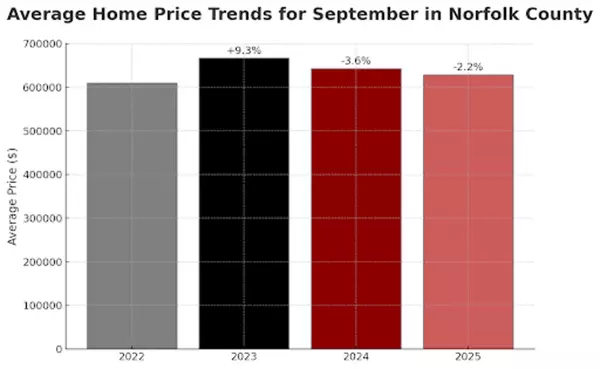Thriving in Uncertain Times: How to Achieve Real Estate Success When Others Struggle
Economic volatility and shifting policy landscapes have made the past few years among the most challenging in modern real estate history. However, even as interest rates rise and construction lags, Canada remains firmly in the grip of a housing shortage: purpose‑built rental vacancy rates across major centres linger at historic lows, ensuring persistent demand from renters.
According to Paul D’Abruzzo, Investment Property Agent, “For investors, this paradox of uncertainty paired with scarcity creates a unique window: those willing to rethink traditional approaches can uncover high‑upside opportunities that more cautious peers overlook.”
Current Market Dynamics
Canada’s rental market has eased slightly from the extreme tightness of recent years, but conditions remain undersupplied in many regions. According to CMHC’s Fall 2024 Rental Market Report, the national vacancy rate for purpose-built rental units increased to 2.2%, up from 1.5% in 2023. While this represents the largest annual jump in over a decade, it still falls short of the historical average of 2.7%.
Rental conditions vary significantly across Canada, meaning that there are areas of increased opportunities, as well. While some cities and neighbourhoods have seen rising vacancies, others, including parts of Metro Vancouver and Halifax, continue to face tight rental conditions, particularly for affordable units. In many cases, vacancy increases have been uneven, with mid- and lower-priced rentals still in short supply despite broader market easing. Looking ahead, if housing construction and development pipelines fail to keep pace with demand in certain areas, rental shortages and affordability pressures are likely to persist or worsen.
At the same time, inflation and high borrowing costs have reduced purchasing power, pushing more households to remain in the rental sector. Homeownership continues to be out of reach for many, reinforcing rental demand.
Municipalities such as Toronto and Ottawa have moved ahead with zoning reforms to enable greater density. Toronto’s multiplex bylaw, passed in 2023, now permits up to six units on single-family lots, creating new challenges and opportunities.
Looking ahead, CMHC forecasts a gradual rebalancing, but not a glut. New supply is expected to continue outpacing near-term demand in some cities, particularly where completions surged. However, structural shortages, especially in affordable and mid-market rentals, persist. Paul D’Abruzzo notes, “Investors who understand local supply and demand will be best positioned to navigate this evolving environment.”

Strategies for Thriving
Paul D’Abruzzo shares some of his key strategies for thriving, even in challenging markets.
Cultivating a Strategic, Flexible Mindset
Success begins with psychological agility. Investors who cling to rigid models or familiar geographies risk being blindsided by rapid change. A strategic mindset entails constant market surveillance—evaluating emerging submarkets, tracking policy shifts, and reassessing capital allocations. It also means embracing asset types outside one’s comfort zone: corporate rentals, student housing, co‑living schemes, or mixed‑use developments often combine higher yields with less competition. By forging partnerships with local experts and deploying data‑driven tools, investors can enter these niches with confidence.
Committing to Time in the Market
Rather than attempting to time peaks and troughs, a strategy that typically underperforms disciplined ownership over decades, investors should focus on sustained market participation. Real estate’s true returns emerge over long horizons, as compounding rental income and gradual appreciation outweigh short‑term fluctuations. Establishing clear acquisition criteria and securing pre‑approved financing enables swift action when attractive deals appear, preventing ‘analysis paralysis’ and missed windows.
Leveraging Real Estate as an Inflation Hedge
Real estate’s dual role as a hard asset and income generator makes it a proven inflation barrier. As consumer prices rise, so too do rents and replacement costs for new housing, driving property values upward. Locking in fixed‑rate debt today allows investors to repay mortgages with future, less‑valuable dollars, magnifying real returns. Well‑located, rent‑regulated or purpose‑built properties, in particular, offer resilient cash flows that keep pace with broader economic trends.
Diversifying Across Geographies and Asset Classes
Limiting your exposure to just a single city or property type leads to concentration risk. A localized economic slowdown or a surge of new supply can undermine returns. Diversification into different regions and property types enables investors to mitigate localized risk and optimize long‑term returns.
A smart real estate strategy includes investing in secondary and emerging markets where lower entry costs and growing local economies can yield higher capitalization rates. Bedroom communities near major cities, like Milton or Mississauga, within Toronto’s commuter belt, offer access to expanding markets with strong demand, presenting attractive opportunities for growth and better returns compared to more expensive urban cores.
At the same time, investors should balance their portfolios by including a mix of property types, such as single-family and multi-family units, alongside niche segments like long-term rentals for families, short-term or vacation rentals, and purpose-specific housing like student residences or corporate suites. This kind of diversified asset mix helps stabilize cash flow across different market conditions and economic cycles.
Reverse Planning from Lifestyle Objectives
Real estate success starts by identifying your end goals and working backward to map out each step. Whether the goal is generating passive income to support early retirement, building equity for future entrepreneurial ventures, or creating intergenerational wealth, Paul D’Abruzzo recommends that investors always articulate their desired lifestyle outcomes first.
Once you have defined these objectives, they can guide your portfolio construction. For example, the amount of annual cash flow needed dictates how many units to acquire, while target markets and financing structures are chosen to align with broader life plans. This reverse‑engineered approach ensures every acquisition moves you closer to your vision.
Maximizing Density through Value‑Add Conversions
As municipal policies increasingly encourage densification, investors have more opportunities to transform underutilized properties into multi‑unit income generators. Converting a detached home into three or more suites, or expanding a triplex into a six‑unit building, can dramatically boost rental income without the expense of new land. Similarly, properties with unfinished basements or attics often present low‑hurdle renovation opportunities. In high‑demand submarkets, these conversions are not only financially viable but also meet urgent community needs for affordable housing.
Identifying suitable properties to split into more suites requires an expert eye and careful cost‑benefit analysis to ensure compliance and profitability, however.
Employing Value‑Add and Government‑Backed Incentives
The BRRRR framework (Buy, Renovate, Rent, Refinance, Repeat) continues to be a powerful model for accelerating equity growth in rental portfolios. Targeted renovations, such as adding accessory dwelling units (ADUs), upgrading kitchens and bathrooms, or modernizing mechanical systems, not only increase property value but can also significantly boost rental income.
Integrating CMHC’s MLI Select program into this process can further amplify returns. This initiative offers reduced mortgage insurance premiums and higher loan-to-value allowances for multi-unit rental projects that meet defined thresholds for affordability, energy efficiency, or accessibility. By meeting these criteria, investors can lower financing costs and increase leverage, improving overall project yield.

Harnessing Data Analytics
Successful real estate investing today relies on a clear, data-driven approach. Market trends can help investors identify promising areas and make informed choices. Tracking local economic conditions, infrastructure projects, and policy shifts helps anticipate market changes and manage risk effectively. Careful analysis supports smarter timing, better cash flow forecasts, and well-balanced portfolios that spread risk across regions and asset classes. Grounding decisions in reliable data and continuous market monitoring is crucial for navigating uncertainty and achieving long-term growth.
Optimizing Tenant Acquisition and Retention
In a competitive rental marketplace, the difference between a vacant unit and a signed lease often hinges on perceived value. Rather than relying on price alone, investors should ensure their properties feature better finishes, amenities, or technology than comparable listings. Coupled with professional marketing, transparent online leasing processes, and responsive property management, these enhancements reduce vacancy durations and foster lease renewals.
Looking for Opportunities, Not Excuses to Sit on the Sidelines
As Paul D’Abruzzo comments, “In today’s real estate landscape, there is still a demand for housing, despite economic uncertainty. This means ongoing opportunities. Thriving when others struggle requires a proactive, informed, and flexible approach to real estate investing.” He also emphasizes that it is easy to become overwhelmed by negative headlines; this can narrow your perspective and blind you to areas where there is potential. By integrating these principles, investors position themselves not just to survive uncertainty, but to outperform during both boom and bust cycles.
Paul D’Abruzzo is a highly experienced real estate investment advisor who has spent over 15 years helping Canadian investors navigate the market with confidence and success. Backed by hundreds of reviews and downloaded by thousands of Canadians, the guide is an essential resource for anyone looking to succeed in today’s evolving real estate landscape. The updated 2025 Canadian Real Estate Investor Playbook: The Secrets to Thriving in ANY Market guides investors on market trends and ways to manage cash flow in uncertain conditions. Designed for investors at every stage, the guide provides a clear roadmap for navigating rising interest rates and changing market dynamics, with a focus on helping readers make informed decisions and position themselves for long-term success.
Recent Posts









